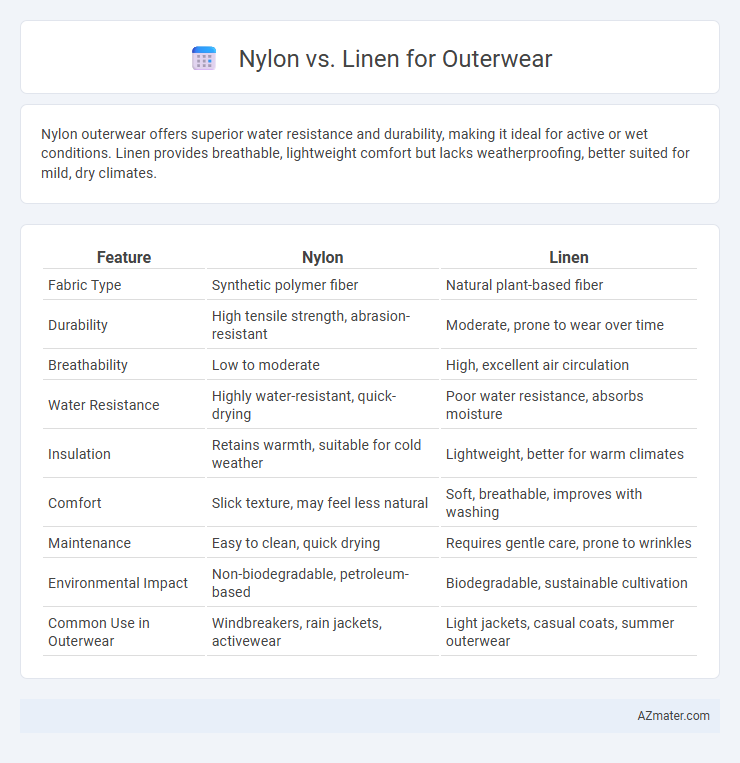Nylon outerwear offers superior water resistance and durability, making it ideal for active or wet conditions. Linen provides breathable, lightweight comfort but lacks weatherproofing, better suited for mild, dry climates.
Table of Comparison
| Feature | Nylon | Linen |
|---|---|---|
| Fabric Type | Synthetic polymer fiber | Natural plant-based fiber |
| Durability | High tensile strength, abrasion-resistant | Moderate, prone to wear over time |
| Breathability | Low to moderate | High, excellent air circulation |
| Water Resistance | Highly water-resistant, quick-drying | Poor water resistance, absorbs moisture |
| Insulation | Retains warmth, suitable for cold weather | Lightweight, better for warm climates |
| Comfort | Slick texture, may feel less natural | Soft, breathable, improves with washing |
| Maintenance | Easy to clean, quick drying | Requires gentle care, prone to wrinkles |
| Environmental Impact | Non-biodegradable, petroleum-based | Biodegradable, sustainable cultivation |
| Common Use in Outerwear | Windbreakers, rain jackets, activewear | Light jackets, casual coats, summer outerwear |
Nylon vs Linen: An Introduction to Outerwear Fabrics
Nylon offers exceptional durability, water resistance, and lightweight properties, making it ideal for outerwear designed for active and wet conditions. Linen, known for its breathability and natural fiber texture, provides superior comfort in warm weather but lacks water resistance and durability for heavy outdoor use. Choosing between nylon and linen depends on the intended climate and activity level, balancing performance with comfort and style.
Key Differences Between Nylon and Linen
Nylon offers superior water resistance, durability, and wind protection, making it ideal for outerwear designed for harsh weather conditions. Linen, a natural fiber, excels in breathability and moisture-wicking but lacks water resistance and durability compared to synthetic nylon. The thermal properties of nylon provide better insulation, while linen remains cooler and more comfortable in warmer climates.
Durability: Which Fabric Lasts Longer in Outerwear?
Nylon exhibits superior durability for outerwear due to its high tensile strength, resistance to abrasions, and ability to repel water, making it ideal for extended wear in harsh conditions. Linen, while breathable and comfortable, is prone to wear and tear, including fading and fiber weakening over time, especially under continuous exposure to moisture and sunlight. Overall, nylon offers a longer lifespan and better performance in outerwear garments where durability is a critical factor.
Weather Resistance: Nylon vs Linen Performance
Nylon offers superior weather resistance compared to linen due to its water-repellent and wind-resistant properties, making it ideal for outerwear in wet and windy conditions. Linen, while breathable and lightweight, lacks moisture-wicking capabilities and absorbs water quickly, reducing its effectiveness in adverse weather. For durable, weather-resistant outerwear, nylon outperforms linen by providing enhanced protection against rain, wind, and cold temperatures.
Comfort and Breathability Compared
Nylon outerwear offers excellent water resistance and durability but tends to trap heat, making it less breathable and comfort-focused in warm conditions. Linen, made from natural fibers, excels in breathability and moisture-wicking, providing superior comfort in hot and humid climates despite being less durable and water-resistant. For optimal breathability and comfort, linen is ideal for lightweight outerwear, while nylon suits more rugged, weather-resistant needs.
Style and Aesthetic Appeal
Nylon outerwear offers a sleek, modern aesthetic with a smooth, often shiny finish that complements urban and sporty styles. Linen outerwear exudes a natural, textured look ideal for casual, relaxed, and warm-weather outfits, emphasizing breathability and organic charm. The choice between nylon's polished, tech-forward appearance and linen's timeless, rustic elegance significantly impacts the overall style statement of outerwear.
Maintenance and Care Requirements
Nylon outerwear requires minimal maintenance, typically needing simple machine washing and quick drying to retain its water-resistant properties, making it ideal for active use. Linen outerwear demands more delicate care, often requiring hand washing or dry cleaning to prevent fabric shrinking and maintain its breathable texture. Both fabrics benefit from proper storage, but nylon is generally more durable and less prone to damage compared to the naturally delicate linen fibers.
Sustainability and Environmental Impact
Nylon production relies heavily on non-renewable fossil fuels and releases significant greenhouse gases, posing environmental challenges compared to natural fibers. Linen, derived from flax plants, offers a renewable resource with low water consumption and biodegradability, reducing its ecological footprint in outerwear applications. Choosing linen over nylon supports sustainable fashion practices by minimizing pollution and enhancing fabric compostability.
Cost Comparison of Nylon and Linen Outerwear
Nylon outerwear typically costs more than linen due to its synthetic production process and enhanced durability, making it a preferred choice for performance wear. Linen, derived from natural flax fibers, is more affordable but may lack the weather-resistant properties of nylon, influencing its pricing in lightweight and breathable outerwear categories. Price variations also depend on brand, fabric quality, and garment construction.
Choosing the Right Fabric: Nylon or Linen for Your Needs
Nylon offers superior water resistance, durability, and wind protection, making it ideal for outerwear intended for active use or harsh weather conditions. Linen excels in breathability and moisture-wicking properties, providing comfort in warm climates but lacks the resilience against wet environments. Selecting between nylon and linen depends on your climate, activity level, and the specific performance features required from your outerwear.

Infographic: Nylon vs Linen for Outerwear
 azmater.com
azmater.com